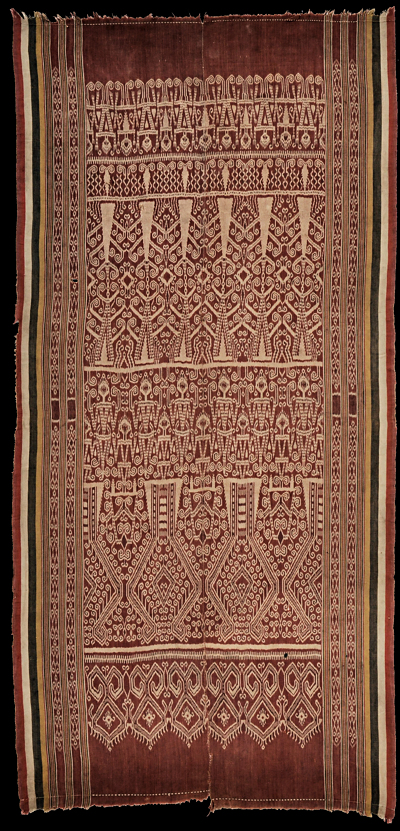| |
369 Borneo, Sarawak
Pua kumbu (blanket)  
|
| Locale: | Saribas river system, probably from the Layar or Padeh rivers |
| Period: | Early 20th c. |
| Yarn: | Cotton, hand-spun, very fine |
| Technique: | Warp ikat |
| Panels: | 2 |
| Size: | 102 x 222 cm (3' 4" x 7' 3") LW: 2.18 |
| Weight: | 500 g (17.6 oz), 221 g/m2 (0.72 oz/ft2) |
| Design: | According to Michael Heppell this is most likely a pua meransang (the latter word means 'stimulation, incitement to passion'), created to encourage men to go out headhunting. It appears to have fire tongs at the base and a tiang (symbolic of an altar piece) on the other side of the presumably female and child figures. Vernon Kedit: 'This simpong (see detail photo below) is reminiscent of the Stambak simpong. A Stambak weaver would never put this in the main field, so the weaver of this cloth made her own interpretation of it, except that she did not fill it with an anthropomorph but disguised the entity with a simple but effective pendant elaborated with tendrils.' |
| Comment: | Contrary to expectation at first sight, this pua was made of hand-spun cotton, very fine; see microscopic images. Noteworthy is the very low specific weight, the second lowest found in any pua in the collection. The fact that this intricately drawn pua was not done in commercial thread but in hand-spun cotton probably means that it predates the 'Stambak revolution' with it focus on intricacy that occurred in the Saribas of the 1930s. The weave is not the common twin warp with twin weft, but twin warp with triple weft - rare in both Sawarak and Kalimantan, but also seen in Saratok pua PC 368. Minor loss of material on selvedges, one tiny hole in the field. |
| Background: | Chapters on Borneo and Sarawak. |
| Compare: | 368 |
| Sources: |  |
| |

©Peter ten Hoopen, 2025
All rights reserved.
|


